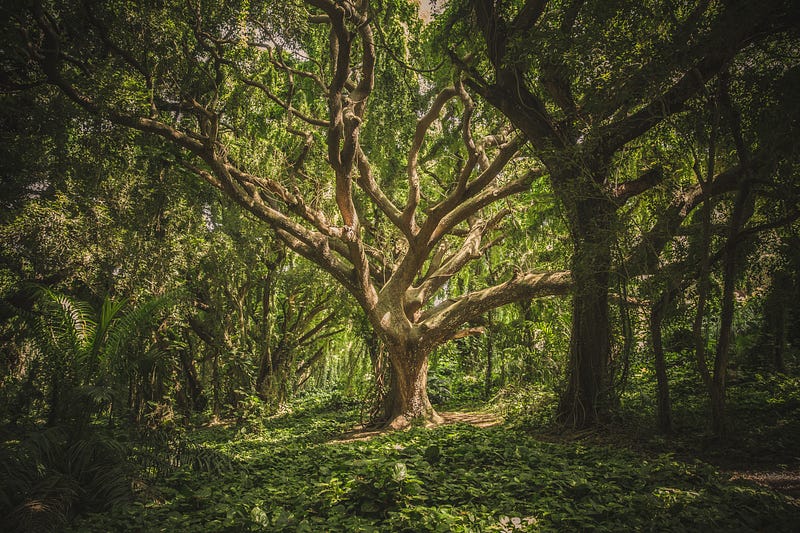The Role of Trees and Algae in Combating Climate Change
Written on
Understanding the Climate Crisis
Can trees really be our saviors in the battle against climate change? For many years, trees have been hailed as key players in mitigating our environmental challenges. From individuals planting millions of them annually to conservationists working tirelessly to protect at-risk forests, there seems to be a collective belief that these natural giants can help rectify the damage we've inflicted. But can they truly save us?
Let's dive into the data!
The Scale of Human Emissions
In 2014, human activities produced an astounding 9.795 billion tonnes of carbon emissions, stemming from agriculture, fossil fuels, and construction. To put this in perspective, this amount is equivalent to the weight of 65,300 blue whales—three times the current population—or 1,632,500 African bush elephants—four times the number of wild elephants. So, how many trees would it take to remove this carbon from our atmosphere each year?
Research indicates that an acre of healthy forest can absorb approximately 2.6 tonnes of carbon annually. While this seems significant, there are two major hurdles: the vast area needed for such forests and the way they store carbon.
The Enormous Land Requirement
To offset the staggering 9.795 billion tonnes of carbon emissions, we would need to cultivate an additional 3.7 billion acres (15.2 million km² or 5.8 million mi²) of mature, thriving forest. This area is slightly smaller than Russia but larger than Antarctica, or nearly double the size of Australia. However, not just any land can be transformed into forest; it requires specific climate conditions, suitable soil, and a diverse ecosystem of supporting organisms.
So, where could we possibly plant this vast expanse of forest? And how long would it take to see any real carbon offset? The reality is that space is limited, and time is not on our side. We must act swiftly without disrupting existing ecosystems.
The Carbon Cycle of Trees
Moreover, when trees absorb carbon, they don't keep it stored indefinitely. The trunks, branches, and roots of trees consist mainly of carbon captured from the air. Upon their death, they decompose—thanks to animals, bacteria, and fungi—releasing that carbon back into the atmosphere. Hence, only actively growing forests or unique ecosystems, like the Amazon rainforest, effectively capture and store carbon.
To truly offset our carbon footprint with trees, we would need to plant an area equivalent to 5.8 million mi² of forest annually. At this rate, we could cover all available land in forests within just over 33 years. Unfortunately, trees alone cannot solve our carbon dilemma.
A Potential Solution: Algae
However, there is hope on the horizon through a much smaller yet powerful organism—algae.
Algae present several advantages over trees, including their lifespan, decomposition process, and efficiency. Unlike trees, which take years to mature, algae grow rapidly and can absorb carbon in just a matter of weeks. This rapid growth leads to algal blooms, which occur when conditions in the ocean become favorable, resulting in an explosion of algal populations.
As photosynthetic organisms, algae utilize carbon from the atmosphere to build their bodies. When they bloom, they effectively capture significant amounts of carbon. Unlike trees, algae do not decompose immediately upon dying; instead, they sink to the ocean floor, where low oxygen levels and layers of additional algae slow down decomposition, allowing carbon to remain trapped.
Algae’s Efficiency in Carbon Absorption
To put it simply, algae do not require continuous yearly increases in population to offset carbon, as their remains can sequester carbon effectively. Remarkably, algae are 400 times more efficient than trees in carbon absorption due to their simpler biological structure and their role in supporting other carbon-absorbing organisms.
So, how much algae would we need to grow to balance our carbon emissions? Algae can theoretically absorb up to three times their weight in carbon, but a conservative estimate suggests that we would need an additional 9.795 billion tonnes of algal biomass each year.
Phytoplankton, a type of single-celled algae, constitutes about 1% of Earth's total biomass, approximately 55 billion tonnes. To achieve our carbon offset goals, we would only need to increase phytoplankton biomass by 17.8%—a target that seems achievable.
Balancing Ocean Ecosystems
However, simply introducing this amount of algae could disrupt ocean ecosystems. The ocean is a delicate balance, and excessive growth in one area can have cascading negative effects. Instead, we should aim to enhance the ocean's productivity without overwhelming its natural balance.
To achieve this, we need to establish marine conservation areas, practice sustainable fishing, and protect coral reefs. In doing so, the oceans could play a vital role in reducing our carbon footprint.
The Continued Importance of Trees
While trees may not be the ultimate solution to our carbon crisis, they are still crucial. Their ecosystems harbor immense biodiversity and significantly influence climate and weather patterns. To ensure a sustainable and comfortable future on Earth, we must maintain healthy forests alongside exploring the benefits of algae.
In conclusion, while trees alone cannot rescue us from climate change, their microscopic counterparts may hold some of the best prospects for combating this human-induced crisis.

An exploration of why simply planting more trees won't resolve our climate crisis.
A discussion on how planting trees can help mitigate climate issues, from food production to flood prevention.